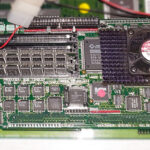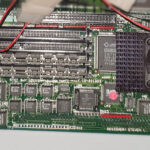
Warp Engine
|
Company
MacroSystem US, USA |
Date
1994 |
Amiga
A3000, A4000 |
Interface
CPU slot |
Autoconfig ID
2203 / 19 |
processor
- 68040 @ 28 / 33 / 40 MHz
- the board was available with an empty CPU socket to put an existing 25 MHz 68040 into it
- the 28 MHz 68040 is an overclocked 25 MHz one
memory
- A4000: four 72 pin SIMM sockets accepts up to 128 MB RAM
- A3000: two 72 pin SIMM sockets accept up to 64 MB RAM
- supports 4, 8, 16, 32 MB, 60-80 ns SIMMs
- 40 MHz version needs 60 ns SIMMs
- 33 MHZ needs 70 ns
- 28 MHz needs 80 ns
- full 040 burst memory access (4/2/2/2 clock cycles – 64 MB/s memory bandwidth)
- configuration
- wait-state jumpers for slow SIMMs
- jumpers for setting the size of the biggest SIMM
- jumpers for double-sided SIMMs
Fast SCSI 2 controller
- NCR 53C710 @ 40 MHz
- 32 bit SCSI host bus DMA interface supporting burst to/from RAM
- max 10 MB/s synchronous transfer speed
- autoboot ROM (warpdrive.device) – can be disabled by a jumper
- incompatible with the A3000’s motherboard SCSI controller – replacing the A3000’s SCSI chip to rev. 08 solves the problem
- external SCSI connector is only available separately
- supported by Linux, NetBSD and OpenBSD
notes
- cannot maprom
- MMU and cache disable jumpers
A3000 notes
- not expected to work with static column RAM on the motherboard
- can provide 25 MHz clock signal to the motherboard (useful for a 16 MHz A3000 system)
jumper settings
| A – | 040: ON – disabled |
| B – | SIMM type: ON – single sided, OFF – double sided |
| C – | SIMM size: ON – 4 megabit chips, OFF 16 megabit chips |
| D – | wait state: ON – enabled |
| F – | MMU: ON – disabled |
| G – | cache: ON – disabled |
| K OFF OFF OFF OFF ON ON ON ON |
J OFF OFF ON ON OFF OFF ON ON |
H OFF ON OFF ON OFF ON OFF ON |
– SCSI config – autoboot disabled – delayed autoboot, LUN scan, asynchronous – delayed autoboot, LUN scan, 200 ns sync – delayed autoboot, LUN scan, 100 ns sync – LUN scan, 200 ns sync – LUN scan, 100 ns sync – 200 ns sync – 100 ns sync |
| E OFF |
L ON |
– reserved |
MacroSystem Warp Engine 4040
| Processor: | 040@40Mhz |
| FPU: | Internal |
| MMU: | Internal |
| RAM: | 64MB |
| RAM Type: | 4 x 72pin SIMM slots |
The Warp Engine is a popular 68040 processor board that replaces the A3640. It includes four 72-pin SIMM sockets and a Fast SCSI-2 host adapter. It may also have been sold without the processor with the intention being that the processor could be removed from your existing A3640 and fitted onto the Warpengine. Any combination of 4M, 8M, 16M, or 32M 72-pin SIMMs, either 32-bit or 36-bit wide. Add them starting with SIMM4 and working down to SIMM1. It is advised that you put your largest SIMM in the SIMM4 socket. EDO SIMMs may be used, but won’t operate any faster than standard ones. For a 28 MHz Warp Engine, 80 ns SIMMs are adequate. A 33 MHz Warp Engine requires 70 ns SIMMs, while a 40 MHz board needs 60 ns. A wait state jumper enables the use of 70 ns SIMMs with 33 and 40 MHz boards (although there is a slight performance reduction). Single or double-sided SIMMs will work, although the double-sided 16M SIMM is not recommended due to high power consumption. All that is required to convert a 28 MHz Warp Engine into a 33 MHz or 40 MHz Warp Engine is to replace the oscillator and processor (although memory SIMMs slower than 60 ns may require jumpering jumper D to enable a wait state). On some variations of the Warp Engine, the 68040 may be soldered in place, making upgrades difficult at best. The WarpEngine also supports an 030 fall-back mode. Note, this mode probably only works if you also have an 030 on the motherboard, eg most A4000’s don’t. You can connect a switch to JP2 with the clock jumper set to internal to disable the RAM and on-board SCSI which may help with very old games.
Memory Setup [courtesy of Steve Kelsey, Warp Engine hardware designer]
“There are two jumpers (the second and third pair of pins on JP2) that select the SIMM slot addressing. One of the jumpers controls whether or not any of the installed SIMMs are dual bank (i.e. 8 or 32 MB). The other jumper controls whether or not any of the SIMMs are 16 MB per bank (i.e. 16 or 32 MB). If the jumpers are set correctly and the SIMMs are installed in a reasonable order, most combinations of SIMMs will result in one contiguous block of memory. A few combinations will result in two or three noncontiguous blocks. The Warp Engine has no limitation on how you mix 4, 8, 16 and 32 MB SIMMs. You can put them in any order and you can set the size and dual bank jumpers any way you want. The automatic DRAM sizing routines figure it all out. But some combinations, while completely legal and functional, are not optimal. So, if you configure your Warp Engine properly, you should be able to get the best performance possible.
Example:
If you have one or more 16 MB SIMMs (and possibly 1 or more 4 MB’s), you should set the size jumper to 16/32 (off) and the dual bank jumper to single sided (on). Then, install your 16 MB SIMMs first, followed by any 4 MB SIMMs. This will make all the 16 MB SIMMs and the first 4 MB SIMM (if present) all one contiguous block.
There are many other combinations that work in a similar way. There are also some combinations that will result in two or more chunks of memory. The thing to remember is that you should propperly set the jumpers according to the types of SIMMs you have, and then install them in a reasonable order.”
Board Layout
__________________________________________________________________
| ::::::::::: JP2 |__Fast_SCSI-2__| JP1 | |
| LKJHGFEDCBA o---- o---- o---- | |
| SCSI Terminators | |
|================================ _________ | |
| SIMM1 | | | 68040 |
|================================ | NCR | | |
| SIMM2 | 53C710 | | |
|================================ | | | |
| SIMM3 |_________| | |
|================================ |____________________|
| +++ +++ SIMM4 |
| +++ +++ |
|____________ |
^ | :::::::::::::::::::::::::::::::::::::::::::::: |
28-40 MHz | :::::::::::::::::::::::::::::::::::::::::::::: |
Oscillator |_____________________________________________________|
Jumpers
JP1: SCSI Termination Power
(Off: termination power not supplied to SCSI bus)
(On: termination power supplied to SCSI bus)
JP2:
A: Mode Select (Off: 68040 enabled, On: 68040 disabled)
B: SIMM Type (Off: double-sided, On: single-sided)
C: SIMM Bank Size (Off: 16M, On: 4M)
D: Wait State (Off: no wait state, On: 1 wait state)
E: reserved
F: MMU Disable (Off: MMU enabled, On: MMU disabled)
G: Cache Disable (Off: caches enabled, On: caches disabled)
H: SCSI Config (see below)
J: SCSI Config (see below)
K: SCSI Config (see below)
JP3: reserved
JP4: used for A3000 version *only* (connects to pin 21 of U350)
SCSI Configuration Jumpers (H, J, K on JP2)
K J H (0=Open, 1=Closed)
- - -
0 0 0 SCSI autoboot disabled
0 0 1 10-second delay, LUN scan, not synchronous
0 1 0 10-second delay, LUN scan, 200 ns synchronous
0 1 1 10-second delay, LUN scan, 100 ns synchronous
1 0 0 no delay, LUN scan, 200 ns synchronous
1 0 1 no delay, LUN scan, 100 ns synchronous
1 1 0 no delay, no LUN scan, 200 ns synchronous
1 1 1 (default) no delay, no LUN scan, 100 ns synchronous
came installed in A3000T

